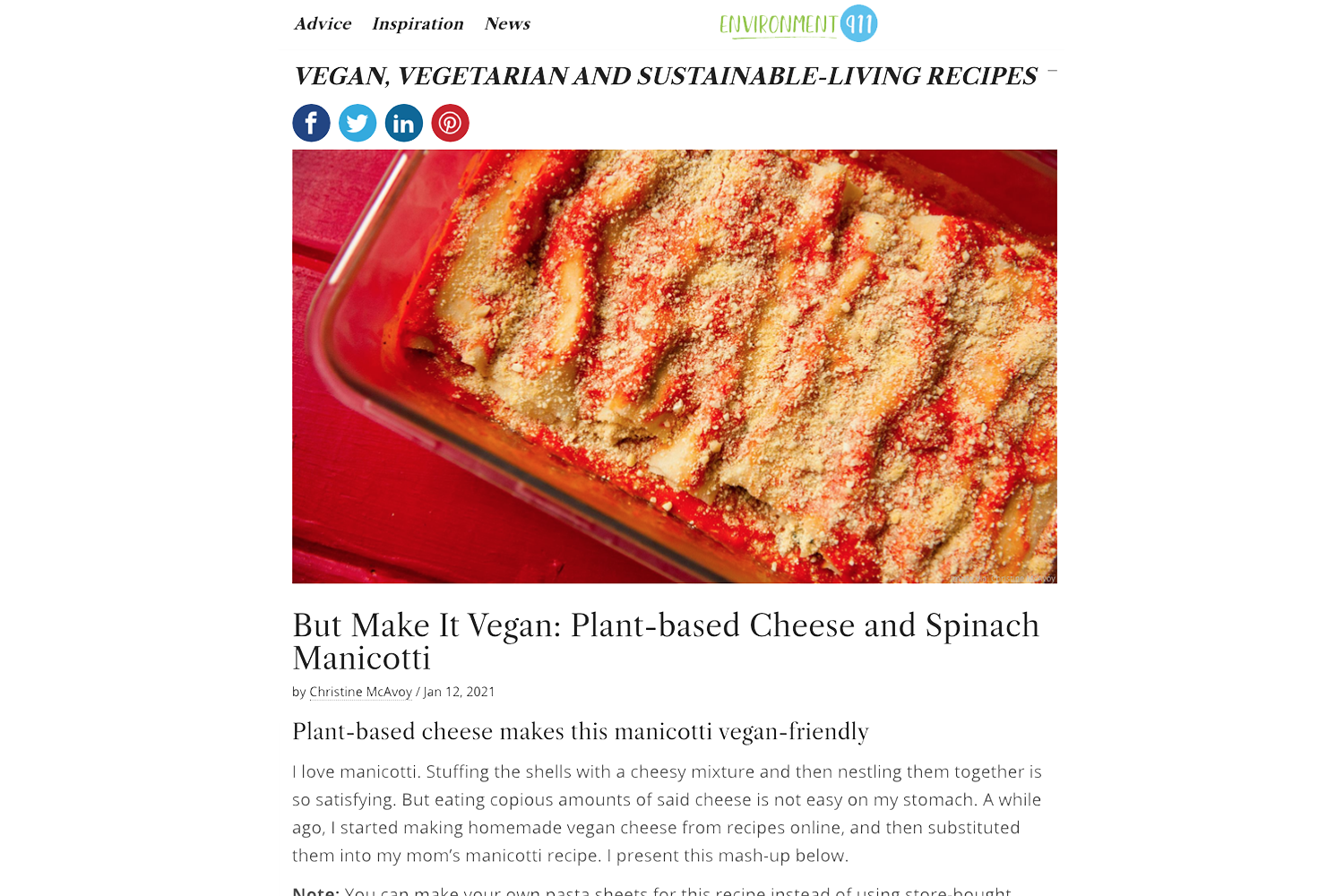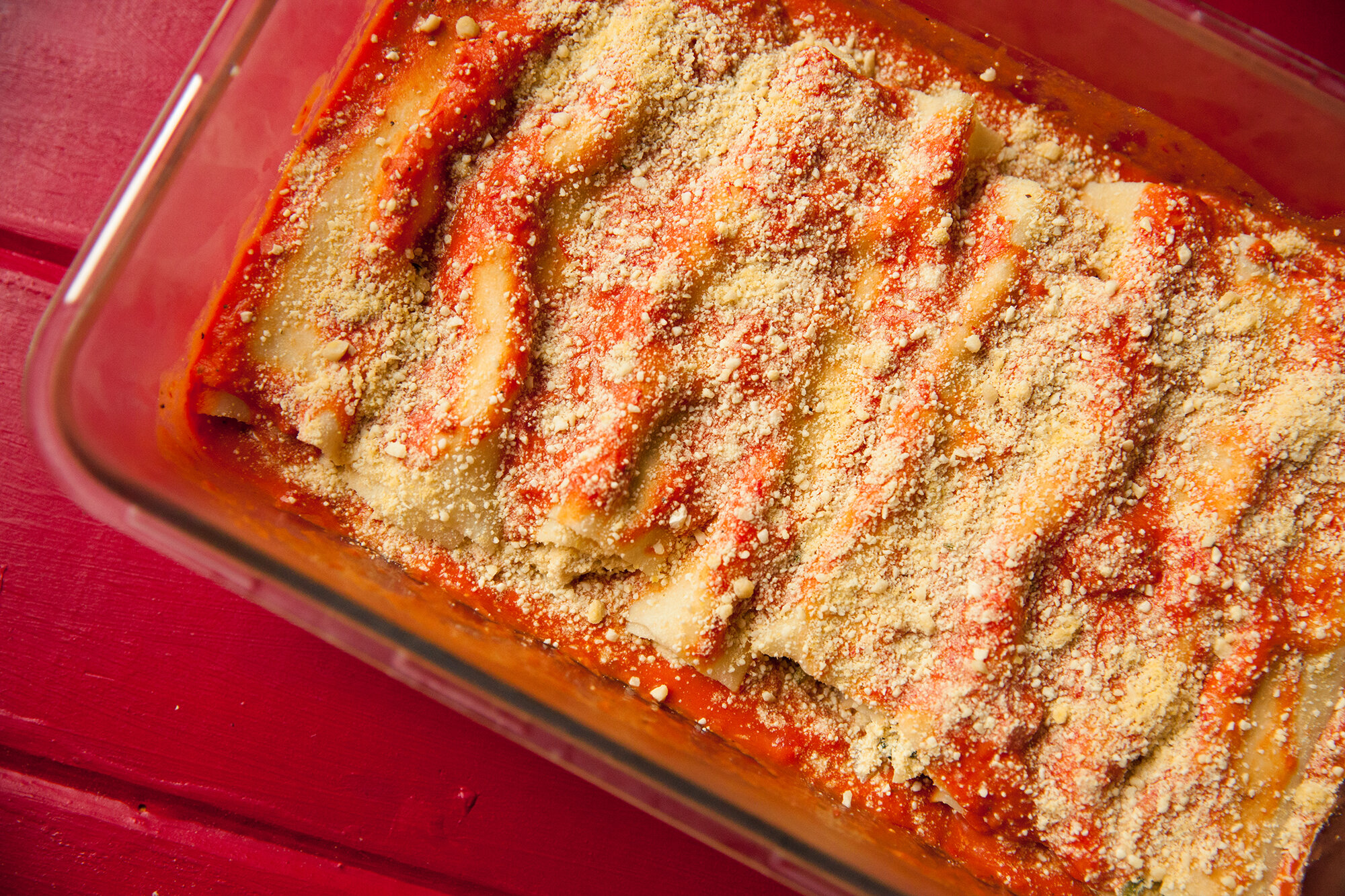



Vegan Cheese & Spinach Manicotti
for Environment911.org
January 12, 2021
BLOG
Vegan Cheese & Spinach Manicotti
for Environment911.org
January 12, 2021
But Make It Vegan: Chocolate Pudding
Recipe for Environment 911
Sometimes you have a craving for pudding (or chocolate in general), but don’t want to over-indulge. This recipe feels like the best of both worlds, as it will curb that chocolate craving and provide nutrition, and you’ll never guess there are avocados in it! You’ll want to adjust the taste based on what you prefer.
More or less banana, or maybe some more cocoa or spices. If you have some picky eaters that prefer a more milk-chocolate taste, you can add a bit of coconut sugar. Just try not to eat it all while you’re taste-testing!
PUDDING INGREDIENTS
2 ripe medium avocados
1 medium banana
1/2 cup cacao powder (double check it’s vegan)
6-8 dates (roughly 1/4 cup)
1/2 cup plant-based milk
1/2 tsp ginger
1/2 tsp cinnamon
1/2 nutmeg, fresh is best if you have it
OPTIONAL TOPPINGS
Non-dairy whipped cream
Fresh fruit
Mint
Sprinkle of fresh nutmeg, or cinnamon
INSTRUCTIONS
Soak the dates either overnight or in a bowl with very warm water for 10 minutes. This softens them and makes them easier to blend. If your blender is high-powered enough, you might not even need this step.
Put all pudding ingredients into a food processor, high-powered blender, or if you don’t have either, try an immersion blender. If the mixture is way too thick, add a bit more non-dairy milk, and if it’s too thin, add more banana or avocado.
Pour into glasses (wine glasses will work) or small bowls.
Optionally chill in fridge for an hour.
Top with desired toppings and serve.
Makes 2 large or 4 small servings

Blog Post for Environment 911
Sustainability in B.C.'s Okanagan Wineries
Oct 19, 2020
Sustainability in B.C.'s Okanagan Wineries
Drinking responsibly takes on a whole new meaning
Organic, natural, sustainable, biodynamic—many of these terms used to sound buzzy or were a rarity in wine production. But more and more wineries, especially in B.C.'s Okanagan region, are taking on the task of creating wine in an eco-friendly fashion.
I did a quick 36-hour trip to the Okanagan to have a peak (and of course a few sips) at some of the many places that boast great strides in sustainability. The height of the summer wine touring season may be over, but you can still get many of these wines at restaurants and wine retailers.
Hopefully this is a starting point for your next trip to wine country to sample, learn and pick up these more eco-friendly bottles...
Okanagan Crush Pad has a variety of labels under its umbrella: Haywire, Free Form, Narrative and the most recent edition, Bizou + Yukon.
Free Form was launched in 2018 to celebrate the winery becoming certified organic—and has some of my new favourite natural wines (I’m also partial to the labels with the design by Vancouver’s Scott Sueme and the paper being made of stone).
The vineyard has a modern design and the patio set-up, which is super-sized for COVID, allows you to sit and choose from set curated flights (much like a beer sampler) with all the information you could desire about what it is you’re drinking, and the science and technique behind how it's made.
After getting some bottles to go, I suggest you take the self-guided tour around the fields next to the winery. You’ll pass by the chickens and ducks hanging out in a pen complete with a coop made with wine barrels.
Click here for where to buy/drink and the wine shop.
It was recommended that I visit Echo Bay winery, as there were some awesome things in sustainability going on. At the helm of the family winery is head winemaker Kelsey Rufiange, whose goal is to create a biodiverse vineyard that is self-sustaining.
As a side project, she created Else Wines (as in something else) so she could be creative with her grapes and techniques (with delicious results).
We were able (and lucky enough) to sit out in the back field and sample some vino from both labels, and learn about the family and Kelsey’s history (check out the info on their site).
Also of note, another wine label produced and bottled on the property is Rigour & Whimsey, which fits right in with the organic philosophy of Echo Bay, centering around regenerative farming and responsible agriculture.
Some of the smaller batch wines (like those of Else) are going to be harder to find, but here are the links for stockists: Echo Bay, Else Wines and Rigour & Whimsey.
One of the themes I discovered through our visits is that if a winery is leaning into sustainability, you’re likely to find some feathered and furry creatures around.
Covert Farms acreage is the ultimate experience when it comes to the farm-to-table mentality. On tours of the property, you'll see chickens and roosters, which you can feed, along with a new rescue pig named Delilah, llamas, farm dogs and cattle. Animals at sustainable wineries aren’t there just to look cute: they fertilize, help with pest management and are natural lawnmowers.
And when it’s time to sit and sample, the spread is much like Covert's philosophy—beautifully made wines, from newly released organic to grand reserve bottles, and a feast of locally or in-house made preserves, cheeses, meats, and fruits (pictured at top). The highlight for me was being guided through it all by the very passionate and knowledgeable staff, and hearing about exactly what goes into making their wine.
Click here to for the wine shop.
There were a lot more places we wished we could have visited on our little sustainable winery jaunt, like Summerhill in Kelowna, Orofino in the Similkameen Valley, Ursa Major and Anthony Buchanan in Oliver and Foxtrot in Naramata. The trip was short due to COVID restrictions and the smoke from the wildfires, which was a reminder why it's so important to consider wineries that pride themselves on their biodiversity and responsible practices.
Broccoli “Cheddar” Soup
for Environment 911 - “But Make It Vegan” Column
Soup season is in full effect! My mom has a great broccoli cheddar soup recipe, but it has a lot of cheese and dairy in it, and my stomach just can't do that anymore. I remembered that Hot For Food does vegan queso with potatoes and carrots as the 'cheddar'...and thought: Maybe I can make a hybrid.
It luckily turned out, for just winging everything, and now you too can have a vegan cheddar broccoli soup on the next cold rainy day. There are a few things that are optional in this recipe, like the Daiya cheese, if you want to make it a bit cheesier, but you could eliminate it, and it would be just as tasty. Also, try your hand at freezing some for a later date, esp. since there isn't any dairy in it to freeze!
----
Makes Approx. 6 to 8 Servings
INGREDIENTS:
- 2 large heads of broccoli WITH the stems (or frozen stems and a large head of broccoli)
- 2 onions, chopped
- 1 large Yukon potato, diced
- 4 cloves of garlic, minced
- 3 carrots, peeled and chopped
- 3 pieces of celery, peeled and chopped
- 7 cups of veg broth
- 1 tsp dried oregano
- 1 cup non-dairy milk
- 1/2 cup cashews
- 2 tbsp olive oil
- salt and pepper
- 3 tbsp nutritional yeast
optional:
- 1/2 cup Daiya (or non-dairy) cheddar shreds
INSTRUCTIONS:
Chop the florets off of the broccoli, and trim any leaves away. Cut the ends off of the stems, and discard, then roughly chop the rest of the stem and set aside. Take the head(s) of the broccoli and cut into small bite-sized florets. In a small pot, steam the broccoli until it is JUST cooked. Too long and they won't hold up in the soup.
In a large, heavy-bottom pot, heat the olive oil over medium heat. Add in the onions, cooking for a few minutes, then the garlic for an additional minute. Next add in the carrots, potato, celery, and broccoli stems, season with a bit of salt and pepper. Stir and sauté for a minute and then add 7 cups of the veg broth and bring to a low boil for 10 mins. In a blender, add the non-dairy milk, and the cashews, nutritional yeast, oregano and blend until creamy.
Working in batches, add in the broth and veg mixture from the pot until everything has been pureed. You can add a few florets of broccoli at this stage as well. Return to the pot when finished blending. If the soup is too thick you can add a little more broth/water/non-dairy milk to thin it out. But it's all preference. You can now add in the broccoli florets that you have steamed, and the non-dairy cheese if you're using it. Heat the broccoli through and it's ready to serve. Season with a bit of fresh pepper and....
ENJOY!
Covert Farms - Oliver, BC
Images from Environment 911 Blog - Sustainability in the Okanagan Winery Circuit
September 24, 2020
Echo Bay Vineyard, Else Wines, Rigour + Whimsey - Okanagan Falls, BC
Images from Environment 911 Blog - Sustainability in the Okanagan Winery Circuit
September 23, 2020
Follow me on Social Media